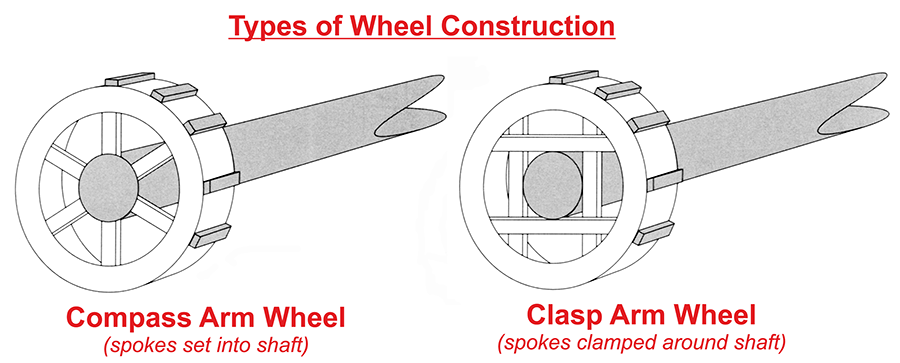
The pictures on this page show the machinery in the CAP, then each of the four floors of the mill, starting at the top with the DUST FLOOR, then the BIN FLOOR, then the STONE FLOOR, and finally the MEAL FLOOR, which is the basement of the mill.
A description of Lacey Green's Brake Wheel, written by the renowned mill historian Stephen Buckland (1935-2006)

In the 17th century many other mills would have had Compass Arm Wheels (where spokes are set into a central shaft) as Lacey Green still has. Most of those mills that still exist have had their wheels modified or replaced with Clasp Arm Wheels (where pairs of spokes are clamped to the sides of a central shaft). Clasp Arm Wheels are a lot stronger than Compass Arm Wheels, which explains why there are so few Compass Arm wheels left.
Lacey Green windmill has a complete set of three Compass Arm Wheels, with the Brake Wheel in the Cap, which engages with the Wallower at the top of the Main Shaft on the Dust Floor, and the Great Spur Wheel, down on the Stone Floor. Photos of all three of these very rare items can be seen further down this page.
Following the breaking of a couple of spokes, in 1990 Lacey Green's Brake Wheel was strengthened with 6 custom made wrought iron brackets, which were hand forged in Shropshire, to wooden patterns cut to fit the spaces in the wheel. They can be clearly seen in the first photo below.
The photos of the Wallower below, set at the top of the Main Shaft, shows that only about a quarter of the timber remains of the main shaft, in between the large cut-outs to accommodate the spokes through the shaft. That explains why the Wind Shaft and Main Shaft at Lacey Green are such massive timbers, as so little of that timber remains.
The wish to preserve Lacey Green's extremely rare three Compass Arm Wheels was the crucial reason for restoring the windmill in 1935, and again from 1971.
The cap is the part of the windmill that automatically rotates to enable the main sails to face the wind. The wind shaft is a huge piece of timber across the centre of the cap. Protruding from the front of the cap, and set into the end of the windshaft is a metal canister which holds the main sails. Inside the cap, and on the windshaft, is a large wheel called the brake wheel. To carry the drive down the mill, teeth on the brake wheel engage with teeth on another wheel called the wallower.
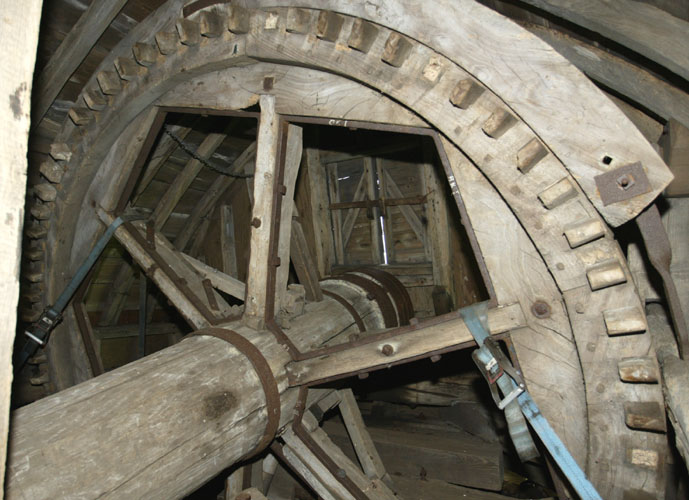
The brake wheel with its spokes radiating from the wind shaft. The brake shoe can be seen over the top of the wheel, it runs right around the brake wheel. The main sails are just outside the doors in the centre of the picture.
Dominant on the top floor is another huge piece of timber, the vertical main shaft which travels down three floors of the mill. On the top of the main shaft is the wallower whose teeth engage with the brake wheel, transferring power (when the main sails turned) down the mill to the machinery on the floors below. The main shaft and the wind shaft are oak, as are the spokes of the brake wheel and the wallower, but their rims are elm, and their teeth hornbeam. They all probably date from around 1650. Also on this floor are two bins or hoppers which store grain and flour for the two machines on the Bin Floor below.
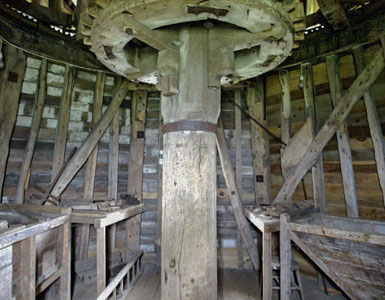
The main shaft in the centre of the windmill.
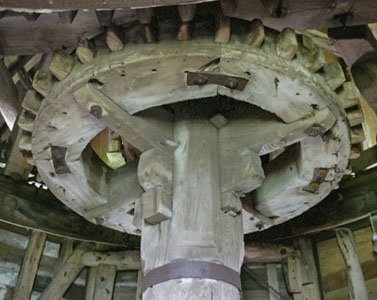
The wallower at the top of the main shaft.
Power is taken off the main shaft by a metal wheel which has been made in two sections to clamp around the wooden main shaft. The wooden teeth mounted on this wheel are beech wood. There are three pieces of machinery on this floor. Firstly, the sack hoist is used to haul sacks of grain or flour up the mill. Secondly, a smutter which is a machine used for cleaning the grain before it was ground. Thirdly, a bolter which is a sifting machine used for grading the flour. The Smutter and Bolter at Lacey Green are 19th century machines that were brought from another mill during the restoration, to replace similar ones that were beyond repair. Also on this floor are two bins or hoppers which are loaded with grain for grinding on the Stone Floor below.
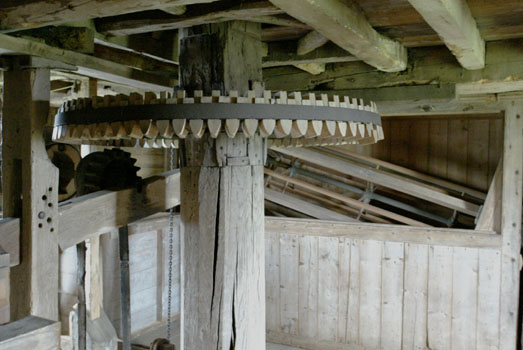
The metal drive wheel (with wooden teeth) for the 3 machines on this floor.
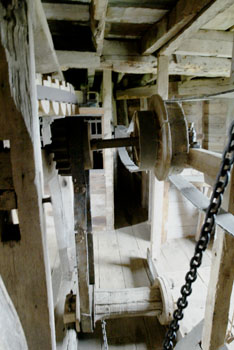
Drive belts, from the days before Health and Safety Inspectors.
On this floor is a large beam which supports the weight of the main shaft. The Great Spur Wheel, in the centre, is used to transfer power to the millstones. Much smaller cog wheels called stone nuts can be engaged with the teeth on the Great Spur Wheel to drive either of two pairs of mill stones. One pair are Derbyshire Millstone grit, used for coarse grinding of oats or barley for animal food. The other pair are French Burr Stone, used for the finer grinding of wheat into flour.
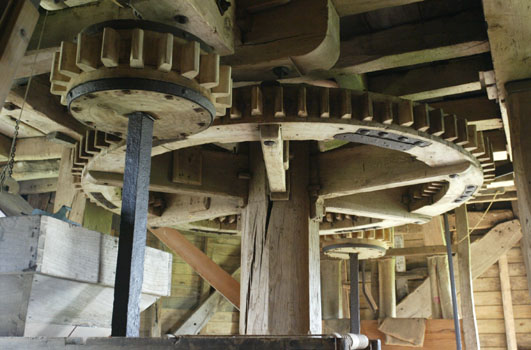
The Great Spur Wheel in the centre, with a stone nut (small cog wheel) each side to drive the millstones.
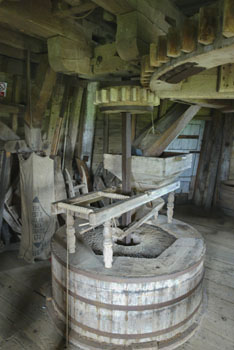
The "Millstone Grit" stones.
Down on this floor, which is below ground level, there are massive timbers around the middle of the floor which support the millstones on the floor above. Between these timbers there are two flour boxes or bins to catch the products being ground by the millstones. The underneath of the bed (or fixed) millstones can be seen above the flour boxes. The weight of the top (or runner) millstones is carried by horizontal timbers on this floor, where adjustments to the gaps between the millstones would be made.
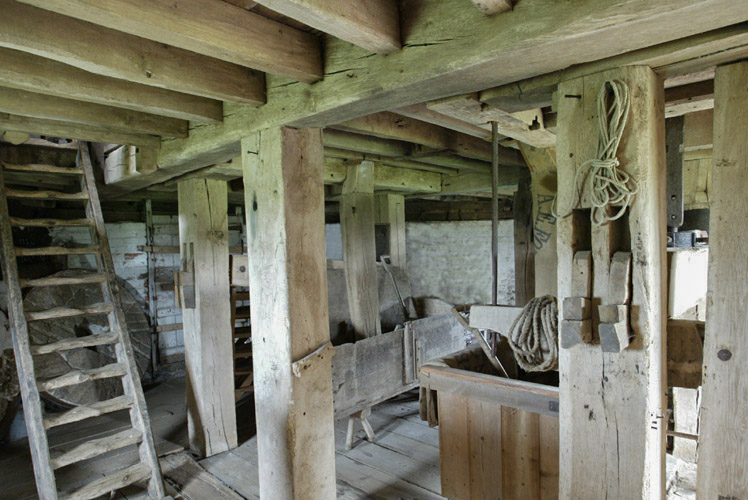
Sacking chutes descend into the two flour boxes in the centre of this floor.
This page ( interior.php ) was last updated on 18 February 2024.
The Chiltern Society is a Registered Charity No 1085163 and a Company Limited by Guarantee Registered in England and Wales Registration No 4138448.